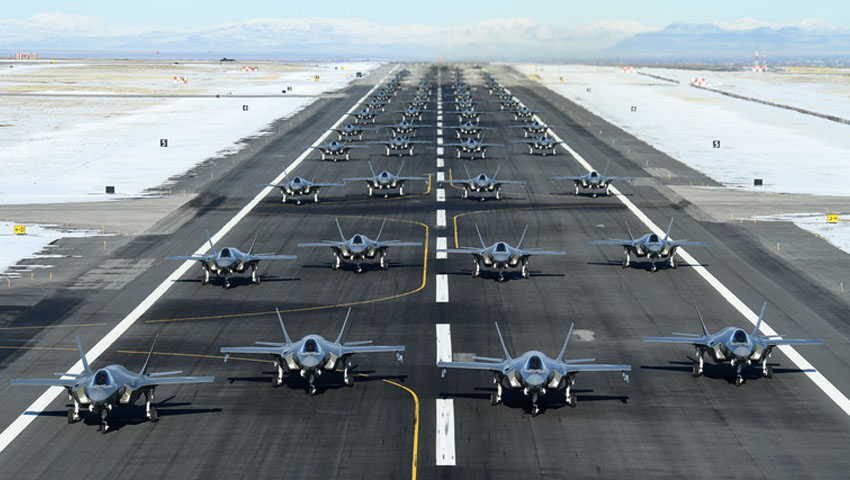A little more than four years after receiving their first combat-coded F-35A Joint Strike Fighter aircraft, Hill Air Force Base’s fighter wings have achieved full warfighting capability – shedding light on the future of the RAAF’s future air combat capability.
To continue reading the rest of this article, please log in.
Create free account to get unlimited news articles and more!
The term describes a set of focus areas within the 388th and 419th Fighter Wings: fully trained pilots and maintainers, a full complement of 78 aircraft and the mission and support equipment needed to fly.
While the designation of full warfighting capability is an important milestone, the wing has been combat capable since the Air Force declared initial operational capability in August 2016.
Since then, the wings have participated in several large combat exercises, deployed twice to Europe and once to the Pacific and supported two Middle East combat deployments, including one short-notice tasking.
Colonel Steven Behmer, 388th Fighter Wing commander, explained, "Every training opportunity, exercise and deployment we’ve completed over the past four years has been a key stepping stone in reaching full warfighting capability.
"This is just the beginning of sustained F-35A combat operations and we will remain focused on staying ready to deploy whenever, wherever we’re needed."
The first F-35As arrived at Hill AFB in September 2015 and the final aircraft arrived in December 2019. In the intervening years, airmen at Hill AFB have been training and developing tactics as the aircraft systems and capabilities have matured.
Reaching the right balance of qualified manning can be a challenge when activating a brand-new weapon system.
The first squadron to stand up, the 34th Fighter Squadron, started with a core of pilots who had some level of F-35A training and experience in other platforms.
As the wing began to grow, that experience level was diluted, and each squadron has been through a period where a majority of pilots could be considered "inexperienced wingmen".
When the first jets arrived at Hill AFB, about 50 per cent of the maintainers were fully-trained, seasoned F-35 maintainers from Eglin Air Force Base, Florida, and Luke Air Force Base, Arizona. That number decreased due to PCS, retirements and separations.
Since then, there has been an influx of new manning with less experience, and every other maintainer has been “homegrown”.
"We really relied on our more experienced personnel, and as we received more aircraft, spread them throughout the group to train and equip the next F-35A aircraft maintenance units the right way. When you have the right mix of leadership, with the right focus, they can empower their people and everyone develops maintenance capability quickly," explained Colonel Michael Miles, 388th Maintenance Group Commander.
When the first aircraft arrived in 2015, the goal was to fully equip each squadron with 24 primary assigned aircraft and six backups by the end of 2019. That was realised in December with the delivery of the 78th jet.
Over that four-year period, the wings received roughly two jets every month and immediately began putting them to use. In the spring of 2016, the 34th FS deployed six jets to RAF Lakenheath, UK.
In some cases, the delivery process became so streamlined that the aircraft were able to fly combat training missions within 24 hours of arriving at Hill AFB. This was more than just convenient. It meant that it was possible to deliver a jet from the factory straight into combat if necessary.
Fifth-generation technology on the F-35A requires more specialised equipment than legacy aircraft. Every system on the F-35A has an associated piece of equipment to keep aircraft loaded, fueled and flying.
There are more than a dozen critical pieces of heavy equipment, from the standard – power generators and weapons loaders, to the unique – 5.8 ton air conditioners to cool the jet’s advanced avionics.
There’s also other equipment – like the high-tech, personalised helmets that integrate with the jet’s mission systems – and computer and network systems to support flying and maintenance.
COL Miles explained the importance of the milestone: "At IOC (initial operational capability), we had the equipment to support one squadron that could do some semblance of combat operations. Now, as each squadron has progressed, and we’re on track to have all the required assets, we demonstrated that we can rely on the program for the technical support and weapons system parts we need while we deployed all our squadrons last summer."
In 2019, the wings proved that they could balance the equipment requirements to support all three squadrons away from home station – the 4th FS was deployed to the Middle East, the 421st FS was in Europe and the 34th FS spent two months at Mountain Home AFB, Idaho.
In a seven-day span, the wings had aircraft, equipment and personnel operating out of nine different countries.
"Through hard work, providing programmatic feedback, and developing new processes and procedures, we shaped and pushed the program. Each airmen can look back with pride and see their contributions over the last four years standing up this wing, and enabling F-35A combat capability for our country," COL Miles added.
Stephen Kuper
Steve has an extensive career across government, defence industry and advocacy, having previously worked for cabinet ministers at both Federal and State levels.

 Login
Login








